Return to Part 1
July 8, 2001 Vientiane, Laos – On Tuesday, June 26, 2001, the Bang Productions, Ltd. crew and I flew from Hong Kong to Hanoi, Vietnam. Through the airline window, I took a photo of the miles of rice fields near the airport, a prelude to the beautiful, watery fields that stretched along all the roads we would travel in Laos.
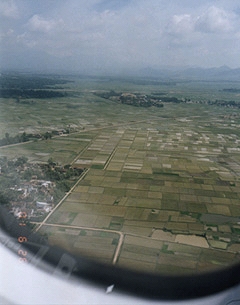
After changing planes in Hanoi, we flew to Vientiane, the capitol of Laos since the mid-16th Century when political power shifted from Luang Prabang (now Louangphrabang), the former royal center. The chief occupation in Laos is agriculture. An estimated 90 percent of the people farm rice. For centuries, political upheavals by powers mainly outside Laos have erupted, including the Vietnam war of the 1960s to 1970s. Yet, Laotian culture has remained closely tied to Buddhist religions and its own traditions of art, literature, music and drama that are largely free of western influence.
After checking in the hotel, Producer Denise Blazek and I took off on a location scout to visit some of the Buddhist stupas by open air taxi.
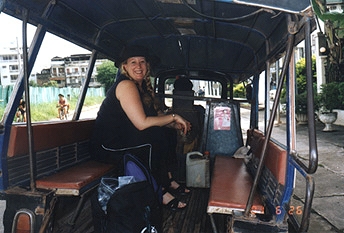
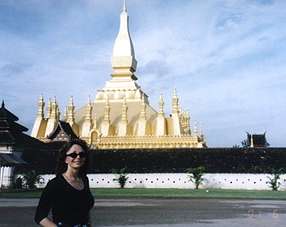
The largest and most spectacular is the Phrathatluang that is said to house some bones from the Lord Buddha. Mr. Soukhasavanh Sanaphay from Vientiane’s Ministry of Foreign Affairs Press Department told me that the shiny gold surface was made from melted gold coins.
A sign posted in front says in both the Lao language and English:
“PHRATHATLUANG – This stupa the original it was built in the 3rd Century and established of the Muang Vientiane in the same time. The stupa for the contain are some bone of the Lord Buddha.
The original a small stupa made by stone during the reign of the great King Xaisethathirath in 16th Century. After the king removed from the Luangphrabang reach to Vientiane in 1560 A.D. and in 1566 A.D. the king has enlargement of the Phrathatluang as we have seen at the present.”
Nearby is a monk’s house upon which are golden scenes of the Buddha’s life above steps protected by two Nagas, Sanskrit for “serpent.”
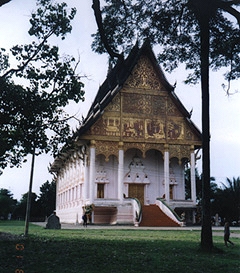
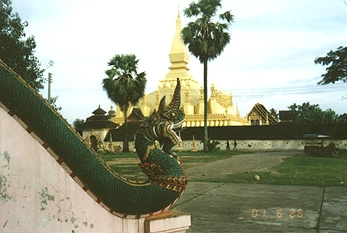
In Hindu and Buddhist mythology, Nagas are semi-divine beings, half human and half serpentine. Their race is said to be strong and handsome and the beings can assume either human or serpentine form. Nagas are superior to humans and considered to be potentially dangerous. Their location on earth is an underground kingdom called Naga-loka, or Patala-loka, which is filled with palaces decorated with precious gems. Brahma himself, the personification of divine reality in a trinity with Vishnu and Shiva, is said to have relegated the Nagas to the underground after their population had grown too large on the surface of the earth. Brahma also commanded the Nagas to bite only the truly evil and so Nagas are frequently carved as door guardians.
The snake king, Mucalinda, protected the Lord Buddha from rain during a seven day meditation. Subsequently, when Nagas are depicted as human beings, there is often a canopy of many snakes over their heads. Nagas are also depicted as half-human with the lower part of their body below the navel coiled like a snake and a canopy of snake hoods over their heads.
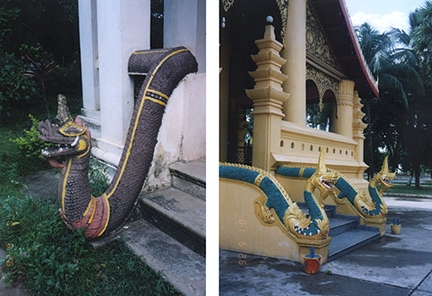
There will be more about Naga mythology in the Bang Productions Ltd. series Modern Mysteries of Asia scheduled for air on The Discovery Channel in late November 2001.
From Vientiane, our group and all the photographic gear were split into two busses for a long road trip to Savannakhet and on to Xepon on the trail of the “Wild Men” of Laos.
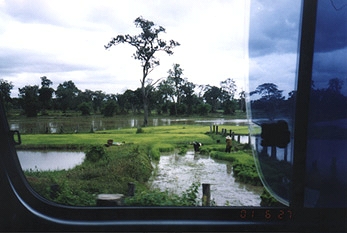
Continued in Part 3: Eyewitnesses Describe the Wild Men of Laos
© 1998 - 2024 by Linda Moulton Howe.
All Rights Reserved.

